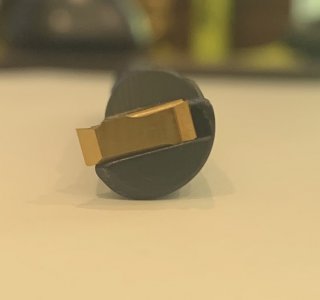- Joined
- Jun 13, 2019
- Messages
- 75
I have several different internal threading tools, every one but this one the tool flats for the holder parallel with cutting edge of the tool so the cutting edge hits the material at 90 degrees. This one is angled down from the flats on the tool so when I clamp it into the tool holder it is angled down. It is a cheap tool but I still I don't understand the angle. Has anyone seen a threading tool angled like this? In the picture I could not get the flats and the cutting edge all in the same pic where you could see it good so I just showed the angle of the cutting edge but the tool is sitting on its flat as it would in a tool holder. Maybe it should be like this but it does not make sense to me but I'm fairly new to lathe work, any thoughts would be appreciated.


